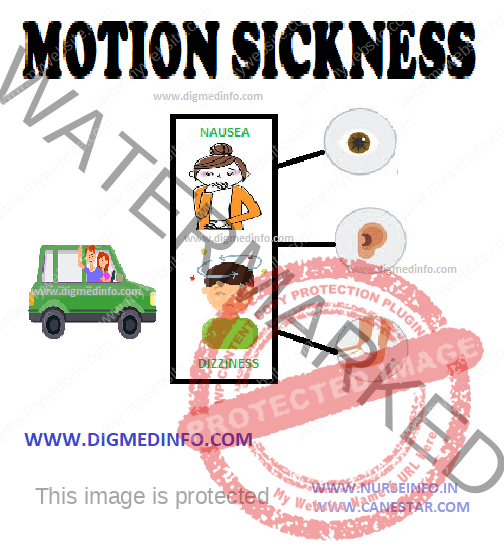MOTION SICKNESS – General Features, Clinical Features, Courses and Prognosis, Prophylaxis and Treatment
General Features
The term motion sickness refers to the clinical picture resulting from movement of an individual on land, sea or air when journeys are undertaken. Repetitive irregular movement as in a swing, a lift or even dancing, may bring on such symptoms.
It is mainly a disorder of gastric and intestinal functions brought on in susceptible subjects while traveling. Irregular and unaccustomed stimulation of the labyrinth causes nausea and vomiting and also disorders of function in the viscera innervated by the vagus or parasympathetic system. During sea voyage the roll and pitch of the ship causes excessive stimulation of the labyrinth. In the case of car and aeroplane travel, labyrinth is subjected not only to the effects of rotation of the body through planes to which it is not accustomed, but also to rapid acceleration, deceleration and altitude changes.
Angular acceleration of train and the linear-angular acceleration of turbulent flights are important causes of motion sickness. Visual stimuli from moving objects and proprioceptive stimuli from muscles and joints contribute to the final outcome. Fear and anxiety make the condition worse.
Early infancy is immune from this affection, since the orienting mechanism has not attained full physiological activity and old age is relatively immune, probably because of the lessened sensitivity of the nervous system. The signs and symptoms of motion sickness occur when sensory information about the body’s position in or movement through space is contradictory to prior experience. Susceptibility and tolerance to motion sickness vary widely among individuals. Motion sickness is more common in women, especially during pregnancy or menstruation, in children aged 2-12 years, and in persons who have migraine headaches.
Clinical features
The initial symptoms include loss of usual sense of well being, abdominal and visceral discomfort, salivation, nausea and yawning. The patient becomes pale and respiration becomes irregular. These symptoms are followed by retching, vomiting and desire to defecate. The vomiting may be mild and transient in some, while in others this may be violent, distressing and recurrent. Headache, giddiness, continued pallor, apathy, lassitude, weakness, dehydration and prostration follow.
The skin may become cold and clammy, tongue coated, both breath and urine may contain acetone bodies, pulse and respiration become rapid and the blood pressure drops.
Diagnosis is easy when the symptoms are related to travel, but other causes of abdominal disorders must not be overlooked.
Course and prognosis
The symptoms usually subside when the travel or the movement causing the condition comes to an end, but in some cases dizziness, headache and gastric symptoms persist for a long time. In cases of long voyages by seas, the symptoms may subside in a few days but may sometimes persist.
Prophylaxis and treatment
Reclining posture, avoidance of visual stimuli and reduction in head movements to the minimum help to minimize the condition. Mental
distraction may help to allay the symptoms. Antihistamines given in small doses 30–60 minutes before starting the travel prevent motion sickness, e.g., diphenhydramine 25-50 mg oral. phenothiazines such as trifluperazine 10 mg or hyoscine (0.3 mg) are good alternatives. To treat motion sickness higher doses of the same drugs have to be given. The choice of drug should be based on the underlying conditions if any.


